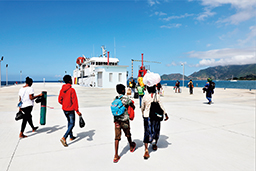ODA Topics 4
Formulation of the Infrastructure System Overseas Promotion Strategy 2025

Passengers boarding a domestic ferry docked at a ferry terminal that was newly constructed with Japan’s cooperation at the Port of Dili, Timor-Leste’s only international port (Photo: JICA)

A trial run of an electric tricycle equipped with a lithium-ion battery at the Indian Institute of Technology. ITSEV, a private company in Toyama City, conducted a formulation survey on a project to improve urban air quality by using lithium-ion batteries suitable for high-temperature climates. (Photo: JICA)
The Government of Japan, in order to achieve economic growth through infrastructure exports, formulated “the Infrastructure System Export Strategy” in 2013 and has been promoting the strategy toward the infrastructure system sales target of approximately ¥30 trillion per year by 2020.
At the 49th Ministerial Meeting on Strategy relating to Infrastructure Export and Economic Cooperation*1 held in December 2020, the “Infrastructure System Overseas Promotion Strategy 2025” was formulated in light of changes in the international environment, including the recent intensification of international competition over infrastructure exports and the rapid progress of digitalization, as well as the impact of the spread of COVID-19. As a five-year target starting in 2021, the new strategy sets a new Key Performance Indicator (KPI) of ¥34 trillion in infrastructure system sales in 2025.
In addition to the original objective of “achieving economic growth” by improving industry competitiveness, the new strategy also sets brand-new policies: “responding to diplomatic issues such as the realization of a ‘Free and Open Indo-Pacific (FOIP)’ through the promotion of quality infrastructure overseas” and “contributing to solving social issues and achieving SDGs in partner countries.” Concerning FOIP, the strategy mentions the formulation of projects related to the establishment of quality infrastructure that will contribute to strengthening connectivity, one of its key initiatives, as well as the promotion of a model that allows Japan to think, develop, and enjoy prosperity together with partner countries and regions in the post-COVID-19 international environment. As for SDGs, the strategy clearly states that there is an urgent need to address critical global issues such as the environment and climate change, infectious diseases, and disaster prevention, and that Japan will make efforts to formulate and participate in infrastructure projects that contribute to solving these issues. With regard to climate change, it is also clearly stated that Japan will promote efforts toward realizing carbon neutrality, that is to reduce greenhouse gas emissions to net-zero, by 2050, and contribute to global decarbonization.
In addition, public-private partnerships have been positioned as one of the pillars of the specific policies of the new strategy. Japan intends to enhance its efforts in infrastructure development, operation and maintenance (O&M), legal system development, human resource development, and other areas by combining various schemes of cooperation, including ODA loans, Private Sector Investment Finance, grant aid, and technical cooperation. As an impressive package that combines the advantages of public funds, including Japan’s ODA, with the technological and financial capabilities of Japanese companies, this will enable Japan to make the most effective and strategic use of development cooperation that contributes to both the overseas expansion of Japanese companies and the socio-economic development of partner countries.
In order to realize the policies set forth in the new strategy while strategically utilizing public funds including ODA, Japan intends to provide developing countries with quality infrastructure that incorporates Japan’s advanced technologies and know-how and promote the overseas expansion of infrastructure in a way that meets the needs of the partner countries (See “ODA Topics” for information on efforts to realize FOIP; for SDGs, Part II-3. “Promoting Efforts to Address Global Issues and Human Security”).
*1 Chaired by the Chief Cabinet Secretary, this meeting is held to discuss important matters concerning Japan’s economic cooperation and to ensure that it is implemented strategically and effectively.
